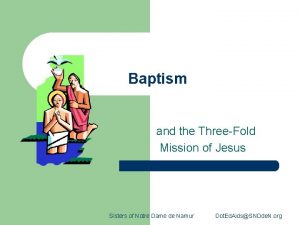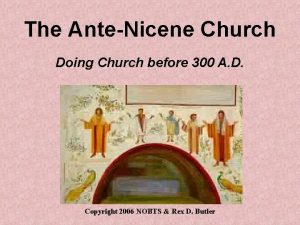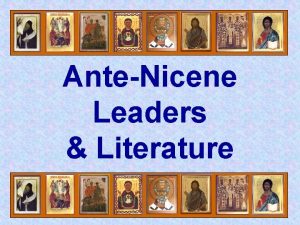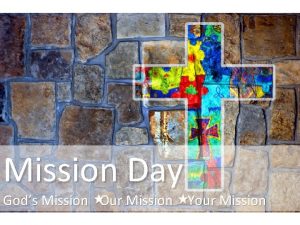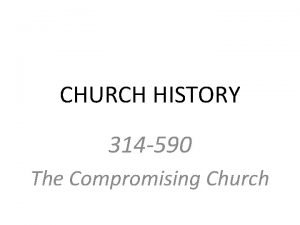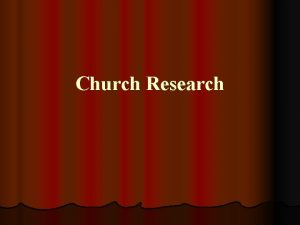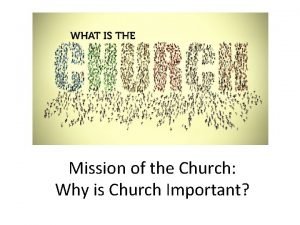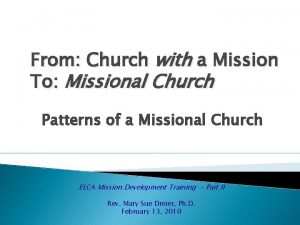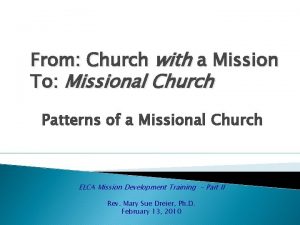12 The AnteNicene Church on Mission Introduction This













- Slides: 13

12 The Ante-Nicene Church on Mission

Introduction • This chapter looks at 100 -325 AD • You can’t understand the history and theology of this period without putting it into a missionary context

The Post-apostolic Context • Basic characteristics of churches – Clusters of small, home-based, urban congregations – Trending toward Hellenistic culture • General factors affecting expansion – Roman roads and Roman law enforcement – Greek language and culture – love of truth – Jewish synagogues attracted God-fearers

Early Church

House converted to church 4 th Century remodel

The Illegal Church • After 100 ad – Rome saw it as a secret sect that threatened stability. • Empire-wide persecution 250, 303 -313 ad • Church in 2 nd century spread along natural routes (ocean, river, Roman roads) – Mesopotamia, Arabia, North Africa, Bythinia – Later to Spain, Gaul, and the British Isles • By the 3 rd century, every province had believers

Growth in the 3 rd Century • Slow urban growth up to 260 • Empire unrest and inflation from 260 -300 – Caused economic hardship for rural people – They questioned the old gods – Christianity made rapid inroad. Perhaps as many as one million converts during the 40 years • Persecution breaks out in 303 ad, lasts 8 yrs – 1500 martyrs, thousands suffered lesser persecution – Many recanted their faith • Persecution ends with Constantine’s rise to power

Whom did God Use? • Missionaries – Missionaries after the Pauline model continued to exist throughout the period – They may have traveled the caravan roads as far as Japan and into India • Missionary Bishops – Bishops of towns evangelized the surrounding area – Irenaeus and Gregory Thaumaturgos (of Pontus) • Lay Missionaries – Christians, especially traders, shared the gospel as they traveled about. – Retired soldiers established churches where they settled – Women evangelized through their networks and through hospitality

How did God Grow His Church • Public preaching by called out evangelists • Catechetical schools taught and evangelized • Private citizens evangelized friends and neighbors, bringing them into their house church • Literature became a rising method

How God Grew His Church • The primary method was personal witness and exemplary living • Also the public testimony at and example of martyrdom • Some won through social service (Harnack’s list: alms giving in general, support of teachers and officials, widows & orphans, sick and infirm, care of prisoners and convicts in mines, burial of paupers, care of slaves, disaster relief, providing employment, and extending hospitality) • Benevolence positively impacted evangelism

Why did the Church Grow • • • The blessing of God Zeal of believers An appealing message Organization and discipline of the church Inclusiveness High ethics

Conclusion – by 325 AD • • Church existed in all parts of the empire Five to six million believers The innovation of literature evangelism Key was the lives and witness of individual believers

Map of
 Christ's three fold mission
Christ's three fold mission Our church's wider mission
Our church's wider mission Hát kết hợp bộ gõ cơ thể
Hát kết hợp bộ gõ cơ thể Frameset trong html5
Frameset trong html5 Bổ thể
Bổ thể Tỉ lệ cơ thể trẻ em
Tỉ lệ cơ thể trẻ em Gấu đi như thế nào
Gấu đi như thế nào Chụp tư thế worms-breton
Chụp tư thế worms-breton Hát lên người ơi alleluia
Hát lên người ơi alleluia Môn thể thao bắt đầu bằng chữ f
Môn thể thao bắt đầu bằng chữ f Thế nào là hệ số cao nhất
Thế nào là hệ số cao nhất Các châu lục và đại dương trên thế giới
Các châu lục và đại dương trên thế giới Công thức tính độ biến thiên đông lượng
Công thức tính độ biến thiên đông lượng Trời xanh đây là của chúng ta thể thơ
Trời xanh đây là của chúng ta thể thơ
